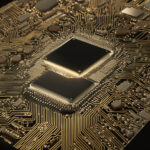China’s 100-Lane Optical Computing Chip Achieves 2,560 TOPS at 50 GHz
Chinese scientists have produced what they claim is the world’s first ultra-high-parallel optical computing integrated circuit. This groundbreaking achievement has the potential to revolutionize the field of computing as we know it. With 100 lanes for data input and output, this optical computing chip boasts an impressive performance of 2,560 trillion operations per second (TOPS) at a frequency of 50 gigahertz (GHz).
Optical computing, which uses light particles instead of electricity to perform operations, has long been hailed as the future of high-speed, low-energy computing. By harnessing the power of photons, researchers have been able to develop chips that far outperform their electronic counterparts. The 100-lane optical computing chip developed in China represents a significant leap forward in this innovative technology.
One of the key advantages of optical computing is its ability to process vast amounts of data in parallel. Traditional electronic chips are limited by the number of electrical connections that can be made on a single chip, leading to performance bottlenecks when handling complex tasks. In contrast, optical computing chips can process data from multiple sources simultaneously, making them ideal for tasks that require massive parallel processing capabilities.
The 100-lane optical computing chip is a testament to the ingenuity and technical prowess of Chinese scientists and engineers. By pushing the boundaries of what is possible in the field of optical computing, they have demonstrated China’s commitment to remaining at the forefront of technological innovation. This achievement not only has implications for the future of computing but also solidifies China’s position as a global leader in cutting-edge technology.
In addition to its impressive performance metrics, the 100-lane optical computing chip also offers significant energy savings compared to traditional electronic chips. Because photons generate less heat and interference than electrons, optical computing systems are more energy-efficient and have the potential to reduce the carbon footprint of data centers and high-performance computing facilities.
The applications of this technology are vast and varied. From accelerating artificial intelligence algorithms to powering next-generation supercomputers, the 100-lane optical computing chip opens up new possibilities for industries ranging from healthcare to finance to transportation. By enabling faster and more efficient data processing, this technology has the potential to drive innovation and create new opportunities for growth and development.
As we look to the future, it is clear that optical computing will play a key role in shaping the next generation of computing technology. With China leading the way in the development of ultra-high-parallel optical computing chips, we can expect to see rapid advancements in this field in the years to come. The 100-lane optical computing chip is not just a technological milestone; it is a sign of things to come in the ever-evolving world of high-performance computing.
In conclusion, the development of China’s 100-lane optical computing chip represents a significant achievement in the field of computing technology. With its impressive performance, energy efficiency, and potential applications, this groundbreaking chip has the power to transform industries and drive innovation on a global scale. As we continue to push the boundaries of what is possible with optical computing, the future looks brighter than ever.
#China, #OpticalComputing, #Innovation, #Technology, #ComputingRevolution












